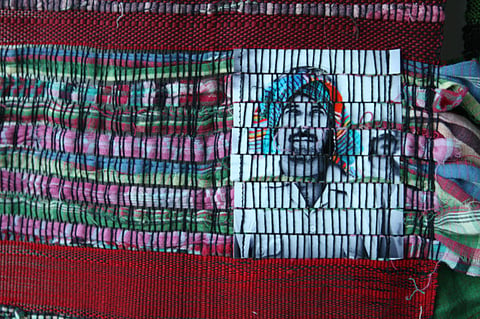The fabric of the Dubai landscape
Elise Vazelakis draws an analogy between the colourful scarves worn by the workers in the city’s construction sites and the city itself

When American artist Elise Vazelakis moved to Dubai three years ago, she was fascinated by the geometric shapes in Islamic art and by the local culture, and incorporated elements from them in her work.
But what particularly caught her attention was the colourful scarves or “gamchas” worn by the labourers working at constructions sites. In her latest exhibition, “The Gamcha Project”, Vazelakis has transformed these simple cotton towels, used by the workers to wipe their sweat and protect themselves from the sun and sand, into beautiful objects of art.
The project pays tribute to the hardworking men who have helped build Dubai by recognising them as the “fabric” of the city’s landscape. And part of the proceeds from the show will go to the “Sameness Project” for their “water for workers” initiative that provides free drinking water to the workers.
Vazilakis was initially driven simply by the desire to collect the scarves because she liked them so much. “The workers are all around the city, and everywhere I went I noticed the lovely colours and patterns on their scarves. I could not resist asking some of them to give me their scarves. It was difficult to communicate with them, but when they finally understood, they were amused and puzzled by my strange request, but happily complied,” she says.
In exchange for their used gamchas, she offered them goody bags and new gamchas. “I know that these gamchas are essential for them. So I had to get them replacements. I looked in all the markets and finally found them in the stores in the labour camps. But the stores did not have anything as colourful and beautiful as the ones they gave me, which they probably got from their home countries,” she says.
After making friends with the workers, the artist also began visiting the construction sites to take photographs of them. Her pictures show the smiling workers wearing a variety of gamchas in different ways. She has also taken many pictures of their hands, to highlight their role in the development of the city. She has incorporated some of the images into her artworks, and published a book of these photographs. “These men are all around us, but people hardly notice them or acknowledge their presence. They were so happy when I interacted with them and posed happily for me,” she says.
After acquiring a huge collection of gamchas, Vazilakis began to think of ways of using them in her art. She decided to use weaving because she liked the idea of weaving these men into the fabric of the city that they have helped to build. She went back to the United States to take lessons in weaving and bought a loom. She then used cotton thread to create her finely woven artworks, in which she has incorporated strips cut out from the gamchas, photographs of the workers, and found materials from construction sites such as ropes, construction tapes, wire, copper twine and nails. The result is a beautiful collection of delicate, colourful, handwoven wall hangings, infused with a deep connection to this city.
“The materials I pick up from the construction sites are dirty, worn out and fragile. Just like the gamchas, I have to clean them thoroughly before using them. But I cannot use new materials because they do not have that history. I did not start out to make a social commentary, but now it seems to me that even the vertical shape of these pieces resembles the tall buildings in Dubai’s skyline. This project is a recognition of the contribution of these workers; and presenting their gamchas in the form of art imparts value to their hard work and sweat,” Vazelakis says.
“I want people to see that there is beauty in everything. Just like the workers are transforming Dubai, I have transformed their gamchas into something beautiful,” she adds.
The artist points out an artwork, where she has woven together pieces of a red and white traditional Arab headscarf, a gamcha and construction tape in the same colours. “The gamcha and the guthra represent different strata of society. But they are both made of cotton and they look the same. This piece underlines the fact that we are all the same, working for the common goal of a better life for us and our families,” she says.
Jyoti Kalsi is an arts enthusiast based in Dubai.
“The Gamcha Project” will run at Showcase gallery until April 15.
Sign up for the Daily Briefing
Get the latest news and updates straight to your inbox



